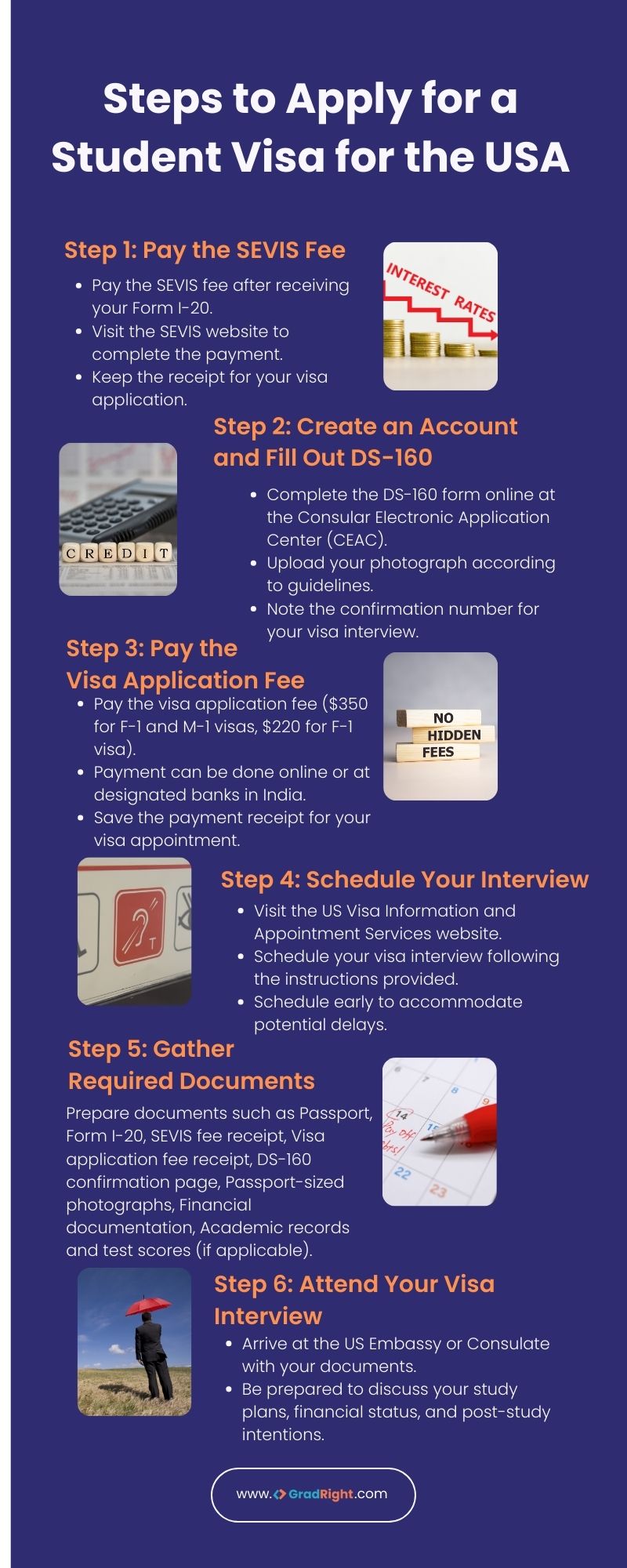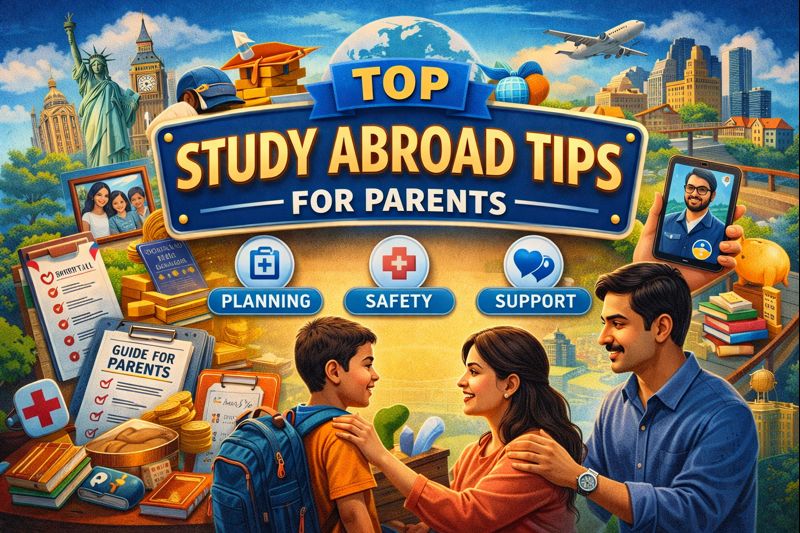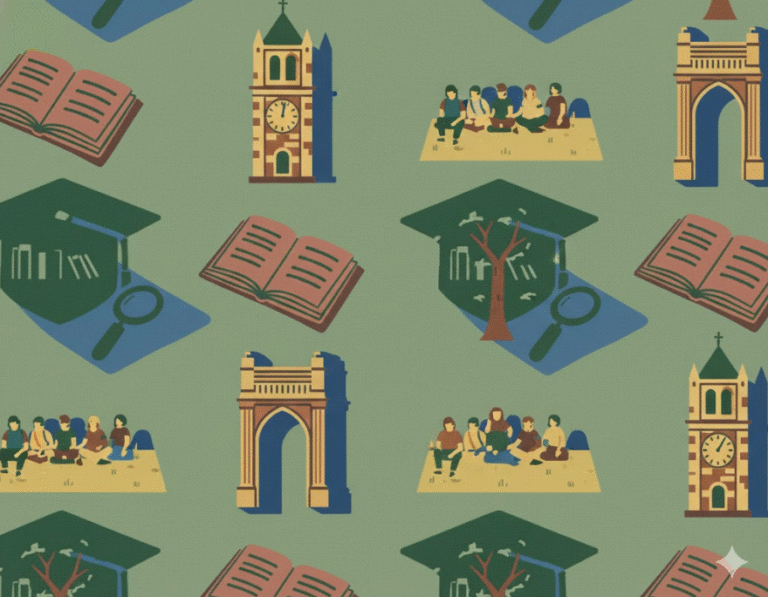Pursuing higher education in the United States is a dream for many Indian students. To make this dream a reality you need a student visa.
Post the COVID-19 pandemic, the number of Indian students going abroad has increased massively. Last year (2024) the US State Department issued 140,000 visas and set a record for student visas issued to Indian students. This year (2025) the consular team of the USA in India is preparing for a significant rise in student visa applications.
The USA student visa system is highly complex and there are many types of visas for students. It is vital for a student who wants to study in the USA to be familiar with the rules and regulations governing each visa type. This article details the various types of student visas in the USA, their respective fees, requirements, and the application processes.
Introduction to student visas for the USA in 2025
A student visa for the United States is a permission that allows foreign nationals to enter the country for the purpose of studying. A student visa allows you to enroll in courses, degrees, and programs at recognized colleges, universities, and vocational or trade schools.
Student visas for the USA are issued by the US Department of State through its embassies and consulates around the world.
Here are the main reasons why obtaining a student visa is necessary:
Legal Authorization
First and foremost, a student visa grants you legal permission to reside in the USA. Without this visa, you cannot gain admission to a school or university or enter the USA. In some cases, your student visa can help bring dependents (such as spouses) from India.
Duration of Stay
The US State Department and Department of Homeland Security track the number of days a foreigner has been residing in the country. A student visa specifies the duration of your stay, which is a very crucial aspect of a student’s study-abroad plans.
Work Opportunities
Some student visas such as the F-1 visa, allow you to work. You can work on-campus or engage in practical training after your studies. A student visa makes it clear that you are legally permitted to work under specified conditions.
Various types of student visas in the USA
There are many types of student visas for the USA. They each cater to specific educational purposes and categories of students.
Each visa category comes with its qualification criteria and benefits. The application process is also through a different form. Below is a broad overview of the main types of student visas for the USA:
F-1 Visa (Academic Student)
The F-1 visa is the most common choice for international students who wish to study in the USA. It allows enrollment in full-time programs in accredited institutions, including colleges and universities.
Qualification Criteria:
- Acceptance into a Student and Exchange Visitor Program (SEVP)-certified educational institution
- Proof of financial support for tuition, living expenses, and other costs
Benefits:
- Full-time enrollment in an academic program is allowed.
- On-campus employment and practical training are permitted.
- After completing your program, you receive a 60-day grace period to prepare for departure or adjust to another visa status.
M-1 Visa (Vocational Student)
The M-1 visa is for students pursuing vocational or non-academic programs in the USA. These programs include fields like culinary skills, nursing, automotive repair, and other vocations.
Qualification Criteria:
- Acceptance into a SEVP-certified vocational institution
- Proof of financial support for tuition, living expenses, and other costs
Benefits:
- Full-time enrollment in a vocational program is allowed.
- You can work on campus, but practical training is not permitted.
- After completing the program, you have a 30-day grace period for departure or transitioning to another visa status.
J-1 Visa (Exchange Visitor)
The J-1 visa is meant for students participating in exchange programs sponsored by the government of the USA or organizations. These programs promote cultural and educational exchange between the USA and other countries.
Qualification Criteria:
- Acceptance into a J-1 exchange program
- Sponsorship by a designated organization
- Proof of financial support for program expenses
Benefits:
- Participation in a structured exchange program is allowed
- There are restrictions on employment after the program
- Provides opportunities to enroll in programs that offer professional development
Note: To be eligible for student visas, you must have a clean record and not pose any security risks. You also have to demonstrate the intention to return to your home country upon finishing your studies.
Understanding the types of student visas in the USA can help you make an informed decision about your stay in the USA. Choose according to your goals to enjoy a successful academic experience.
Comparison of different types of USA student visas
International students planning to study in the United States must carefully consider their visa options. The application process for F-1, J-1, and M-1 visas has specific rules.
To help students make informed decisions, the following table compares the F-1, J-1, and M-1 visas based on purpose, eligibility, work opportunities, and other key factors.
| Criteria | F-1 Visa | J-1 Visa | M-1 Visa |
| Purpose | Academic studies at accredited institutions | Exchange programs at US institutions, often funded by educational or non-profit sponsors | Vocational or non-academic training |
| Eligibility | Admission to SEVP-certified school, issuance of Form I-20 | Admission to a program approved by the US Department of State, issuance of Form DS-2019 | Admission to SEVP-certified vocational institution, issuance of Form I-20 |
| Work Opportunities | On-campus work up to 20 hours per week during term; full-time during breaks; OPT after studies | On-campus work; Academic Training (AT) up to 18 months after graduation for UG and PG students and 36 months for PhD students | No work during studies; limited practical training after program completion with USCIS authorization |
| Home Residency Requirement | None | Must return to home country for 2 years after program completion | None |
| Dependents | Spouses and children under F-2 visas; F-2 dependents cannot work | Spouses and children under J-2 visas; J-2 dependents may study and need authorization to work | No work allowed for dependents |
| Program Flexibility | Can change institutions or programs easily | Limited to program-specific terms and conditions | Cannot change the course of study or transfer institutions more than 6 months after starting the program |
| Application Process | Complete the DS-160 form.Pay the SEVIS fee.
Attend the visa interview. Prepare documentation (passport, Form I-20, etc.) |
Same as F-1 Visa | Same as F-1 Visa |
| Post-Completion Work | Eligible for OPT, which allows up to 12 months of work in the field of study | Eligible for Academic Training (AT) related to the field of study for up to 18 months after graduation or 36 months after the PhD | Limited to practical training after program completion with USCIS authorization |
Requirements for different types of study visas for the USA
The US Department of State has set out the following mandatory requirements regarding student visas. To be eligible for a student visa ensure that you meet these:
- You must have a passport with at least six months validity beyond the intended visa expiration. For instance, a visa ending on September 15, 2028, necessitates a passport valid until March 15, 2029 or later.
- Complete the online nonimmigrant visa application, Form DS-160. The confirmation page must be submitted electronically.
- A non-refundable fee of $350 is required for the student visa application.
- A recent passport-sized photo is needed for the DS-160 application.
- Either Form I-20 (F-1 and M-1 visas) or Form DS-2019 (J-1 visas) from the US institution is essential.
- You have to show proof of sufficient funds for education, living, and travel expenses in the USA.
- You must show documentation demonstrating an intention to return to India after completing education.
- Official transcripts, diplomas, degrees, or certificates from previous institutions are necessary. Standardized test scores might also be required.
Process to apply for student visas for the USA
In this section, we outline the necessary steps to apply for a student visa.
Step 1: Pay the SEVIS Fee
Once you receive your Form I-20 from your school, the first step is to pay the SEVIS (Student and Exchange Visitor Information System) fee. This fee is crucial for maintaining your SEVIS record.
- Visit the SEVIS website to pay your fee.
- Make sure to keep the receipt, as you will need it for your visa application.
Step 2: Create an Account and Fill Out DS-160
After paying your SEVIS fee, the next step is to complete the DS-160 form, which is the Online Nonimmigrant Visa Application.
- Go to the Consular Electronic Application Center (CEAC).
- Fill out the required information and upload your photograph according to the specified guidelines.
- Take note of the confirmation number. You’ll need this for your visa interview.
Step 3: Pay the Visa Application Fee
Now it’s time to pay the visa application fee, which is essential for processing your student visa application. Currently, the SEVIS fee for an F-1 and M-1 visa in the United States is $350. For an F-1 visa, the amount is $220.
Payment can be done online or through banks in India designated by the US Embassy. Make sure to save the payment receipt, as you will also need this for your visa appointment.
Step 4: Schedule Your Visa Interview
After you have completed the previous steps, you can schedule your visa interview.
- Visit the US Visa Information and Appointment Services website.
- Select the option to schedule an appointment and follow the instructions provided.
It is recommended to schedule your interview as early as possible to accommodate any delays.
Also Read: OFC Appointment for USA Visa (GradRight’s Guide)
Step 5: Gather Required Documents for the Interview
Prepare the necessary documents for your visa interview. Here is a list:
- Passport valid for at least six months beyond your intended stay
- Form I-20 from your school
- SEVIS fee payment receipt
- Visa application fee receipt
- DS-160 confirmation page
- Recent passport-sized photographs as per specifications
- Financial documentation proving your ability to pay for tuition and living expenses
- Academic records and any standardized test scores (if applicable)
Step 6: Attend Your Visa Interview
On the day of your interview, arrive at the US Embassy or Consulate with your documents ready. Be prepared to answer questions about your study plans, financial status, and intentions upon completing your studies.

Addresses of Embassy and Consulates of the USA in India:
Embassy of USA in India
- Address: Shantipath, Chanakyapuri, New Delhi – 110021
- Phone: 011-2419-8000
Consulates of USA in India
- Chennai: Gemini Circle, Chennai 600 006, Phone: 044-2811-2000
- Hyderabad: Survey No. 115/1, Financial District, Nanakramguda, Hyderabad, Telangana, 500032, Phone: 040-6932-8000
- Kolkata: 5/1, Ho Chi Minh Sarani, Kolkata – 700071, West Bengal, India, Phone: 033-6827-2400
- Mumbai: C-49, G-Block, Bandra Kurla Complex, Bandra East, Mumbai 400051, Phone: 022-2672-4000
Note: For many students, the idea of getting a visa to the USA may sound daunting. This is because of the very selective process adopted by the US embassy, while granting visas to students. However, given the record number of visas granted to Indian students in 2023, there is every reason for you to believe that you can get your visa to study in the USA. Also, please note that just like getting the visa, getting admission to the right university will be one of the most crucial milestones of your study-abroad journey. And SelectRight can help you in a big way.
SelectRight uses an AI algorithm that evaluates over 8 million data points to pinpoint the best universities and programs for you. It considers your academic, financial, and professional profile to generate a shortlist of universities where you have the highest chances of admission, funding opportunities, and alignment with your career aspirations.
Here’s how SelectRight works:
- Create an account and complete your profile, including your academic scores, preferred program, and budget.
- The AI algorithm processes your information to generate a custom list of programs and universities that match your criteria.
- Compare these options with detailed insights such as profile match score, program fundability, and ROI.
- Finalize your decision with the help of expert advice from our guidance counselors.
- Connect with alumni and experts to start building your community.
By following these steps, SelectRight simplifies your search for the ideal study program abroad.
FAQs
1. Can I travel on an F-1 visa?
Yes, you can travel on an F-1 visa. But there are specific guidelines to keep in mind regarding international travel.
Your passport should be valid for at least six months beyond your intended return to the USA.
Your F-1 visa must be valid for re-entry into the US. If your visa has expired while you are outside the USA you will need to apply for a new visa before you can return.
2. What are the limitations imposed on students in the USA with a visa?
Students in the USA on a student visa face specific limitations to ensure they maintain their student status. Some common restrictions include:
– Students must be enrolled in a full-time course at a recognized college or university.
– Extended absences from the USA can affect visa status and it can be revoked.
– Working off-campus without proper authorization can lead to visa cancellation.
3. How early should I apply for my student visa?
You can apply for your F-1 visa up to 120 days before your program start date.
But we strongly recommend applying earlier than 120 days. There might be processing delays and it is better to be safe than sorry. Apply for the visa right after you secure admission.
4. What financial resources must I demonstrate for a US visa?
To obtain the visa, you must demonstrate sufficient financial resources to cover your tuition, living expenses, and return transportation.
Your bank statements should show funds to cover at least one year of expenses as listed on your I-20.
If you have education loans for studying abroad, provide loan approval letters. In case your family is providing financial resources you need to detail the amount and source of funding.















